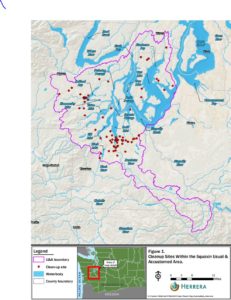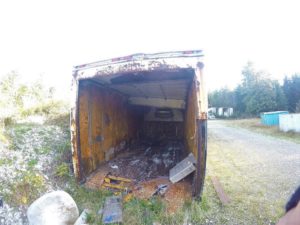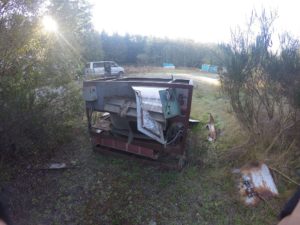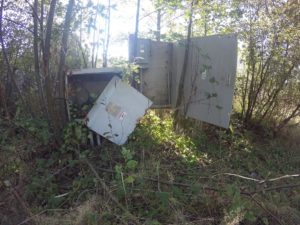Brownfields Tribal Response Program
Brownfields Tribal Response Program
The Squaxin Brownfields Tribal Response Program (TRP) started in 2018 as an environmental program within the Squaxin Tribe Natural Resources Office. Squaxin Island Tribe receives annual funding from the Environmental Protection Agency (EPA) to maintain the program.
What is a brownfield site?
Brownfield sites are abandoned, idled, or underused industrial and commercial properties where development, redevelopment, or expansion is complicated by actual or suspected environmental contamination. By investigating and cleaning up brownfield sites, many of which are abandoned areas that may impose an environmental risk to the local community, development can take place with less concern about legal liabilities related to site contamination. The site is not necessarily contaminated, but it is not assumed to be “clean” because of its prior commercial or industrial use. This benefits the Squaxin Island Tribe by bringing jobs to the area, making abandoned property functional, and possibly preserving sites that have historic and cultural significance. For more information about brownfield sites, visit U.S. EPA, Brownfields
Brownfields Clean Up Sites
Squaxin is checking initial federal and state database screenings for sites on the reservation that are potential brownfield sites. Those include underground storage tanks that may already be decommissioned, illegal garbage dumps that have partial records of cleanup. Outside the reservation, we are meeting with WA State Dept. of Ecology to discuss their cleanup progress on existing sites.
After meeting with Ecology final changes were made to the inventory, resulting in a complete inventory of 234 sites. This inventory still includes multiple listings for some sites, which will be further evaluated under Phase 3. The database reflecting these sites was submitted to the SIT. Figure 1 depicts the locations of all of these sites within the SIT U&A.
The highest priority areas for the SIT are those near Oakland Bay and Budd Inlet and near areas currently or potentially used for shellfish harvest. These areas are shown in Figure 2. There are 145 sites identified within 1/4 mile of these high priority areas. These attributes were added to the inventory database to allow easy sorting.

Brownfield sites can potentially include:
- Abandoned warehouses and industrial properties
- Old buildings, factories, gas stations
- Open/illegal dumping (particularly involving hazardous wastes such as gas, oil, pesticides, paints, etc).
- Above-ground or underground fuel storage tanks that are abandoned or suspected to be leaking
- Drug labs: Materials found at these sites are extremely hazardous; don’t investigate yourself. If you suspect a drug lab in operation or discover a location you suspect might be a former drug lab, call the police immediately.



Squaxin Tribe Public Record
Some considerations for Brownfield site prioritization include:
-
- Should sites classified as Cleanup Started sites rank higher than Awaiting Cleanup, because there is already momentum and an identified site owner?
- What sites have the highest risk pollutants, and are they mobile in water?
- Which sites may cause immediate health risk to aquatic species?
- Which sites are located over critical aquifer recharge areas or immediately on shellfish beaches?
- Eliminate certain sites as highest priority because of our existing knowledge of them, for example, duplicate sites with the same address.
- Develop a criteria appropriate to use for further ranking all of the remaining sites.
- Draft criteria appropriate for selecting the top 10 to 15 sites.
- Initiate communication with the City of Shelton and with the City of Olympia to discuss the cities’ priorities for cleanup (since there are so many contaminated sites in both of these downtown areas.)
Squaxin Brownfields Site Inventory
Squaxin Brownfields Public Record
We welcome you to look through the records and if you have any questions or comments please contact Leila Whitener 360-432-3822, in the Tribe’s Natural Resource Department.
Brownfield Informational Flier
Report a Brownfield site
The Squaxin Island Brownfield TRP can only investigate what it knows about. For this reason, input from the community is crucial. We encourage any information you can provide about potential brownfield sites on the reservation as well comments on sites we are currently working with. Contact the Squaxin Island Department of Natural Resources with your questions, suggestions, or comments.
Note: This project has been funded wholly or in part by the United States Environmental Protection Agency under assistance agreement (RP-00J51304-0) to the Squaxin Island Tribe. The contents of this document do not necessarily reflect the views Page 20 of 29 and policies of the Environmental Protection Agency, nor does the EPA endorse trade names or recommend the use of commercial products mentioned in this document.
Links
U.S. Environmental Protection Agency Brownfields
Washington State Department of Ecology Toxics Cleanup
U.S. EPA National Priority List